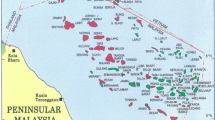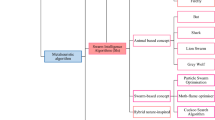Abstract
In pumping optimization of coastal aquifers, the evaluation of the objective function and constraints using density-dependent models is overwhelmed by complex and time-consuming numerical simulations. To address those cases where the available density-dependent model runs are very limited, due to excessive computational burden, an efficient optimization strategy is developed. The proposed methodology uses an efficient sharp interface model jointly with a complex density-dependent model in an evolutionary optimization algorithm. While most evaluations are based on the sharp interface model, the density-dependent model is selectively called to evaluate promising solutions and to improve the predictions of the sharp interface model through the adaptive modification of the saltwater-freshwater density ratio. The method is tested for pumping optimization problems in confined and unconfined coastal aquifers with multiple pumping wells. The optimal solutions are compared to those obtained by density-dependent as well as by sharp interface optimization alone. Under a very restrictive computational budget, the best feasible solution is attained in less than 25 density-dependent model runs for two optimization problems of 10 and 20 decision variables. The results indicate that this optimization method leads to good feasible solutions and that an improved estimation of optimal pumping rates can be achieved within a limited computational budget. The method could also stand as an efficient preliminary exploration of the optimal search space, to provide good feasible starting points for the implementation of more comprehensive methods of coastal aquifer management.




Similar content being viewed by others
References
Abarca E, Carrera J, Sanchez-Vila X, Dentz M (2007) Anisotropic dispersive Henry problem. Adv Water Resour 30:913–926
Ataie-Ashtiani B, Ketabchi H (2011) Elitist continuous ant colony optimization algorithm for optimal management of coastal aquifers. Water Resour Manag 25:165–190
Ataie-Ashtiani B, Ketabchi H, Rajabi MM (2014) Optimal management of a freshwater lens in a small island using surrogate models and evolutionary algorithms. J Hydrol Eng 19:339–354
Bear J, Verruijt A (1987) Modeling groundwater flow and pollution (Vol. 2). Springer Science & Business Media
Bhattacharjya RK, Datta B (2005) Optimal management of coastal aquifers using linked simulation optimization approach. Water Resour Manag 19(3):295–320
Cheng AH-D, Ouazar D (1999) Analytical solutions. In: Bear J, Cheng AH-D, Sorek S, Ouazar D, Herrera I (eds) Seawater intrusion in coastal aquifers—concepts, methods and practices. Kluwer Academic Publishers, Dordrecht
Christelis V, Mantoglou A (2013) improved sharp interface models in coastal aquifers of finite dimensions. In EGU general assembly conference abstracts vol. 15. p 12228
Christelis V, Mantoglou A (2015) Pumping optimization of coastal aquifers using radial basis function metamodels. Proceedings of the 9th World Congress of EWRA ‘Water Resources Management in a Changing World: Challenges and Opportunities’ 10–13 June 2015, Istanbul, Turkey
Christelis V, Kopsiaftis G, Mantoglou A (2012) Coastal aquifer management under drought conditions considering aquifer spatial variability. IAHS-AISH publication 293–297
Dausman A, Langevin C, Bakker M, Schaars F (2010) A comparison between SWI and SEAWAT—the importance of dispersion, inversion and vertical anisotropy. 21st Salt Water Intrusion Meeting, Gov. of Azores, Azores
Dokou Z, Karatzas GP (2012) Saltwater intrusion estimation in a karstified coastal system using density-dependent modeling and comparison with the sharp-interface approach. Hydrol Sci J 57(5):985–999
Efstratiadis A, Koutsoyiannis D (2002) An evolutionary annealing-simplex algorithm for global optimization of water resource systems. Proceedings of the Fifth International Conference on Hydroinformatics, Cardiff, UK, International Water Association Publishing 2:1423–1428
Efstratiadis A, Nalbantis I, Koutsoyiannis D (2014) Hydrological modeling of temporally-varying catchments: facets of change and the value of information. Hydrol Sci J 60(7–8):1438–1461
Essaid HI (1986) A comparison of the coupled fresh water-salt water flow and the Ghyben-Herzeberg sharp interface approaches to modeling of transient behavior in coastal aquifer systems. J Hydrol 86(1–2):169–193
Ferreira da silva JF, Haie N (2007) Optimal locations of groundwater extractions in coastal aquifers. Water Resour Manag 21:1299–1311
Forrester AIJ, Keane AJ (2009) Recent advances in surrogate-based optimization. Prog Aerosp Sci 49:50–79
Graf T, Therrien R (2005) Variable-density groundwater flow and solute transport in porous media containing nonuniform discrete fractures. Adv Water Resour 28:1351–1367
Karatzas GP, Dokou Z (2015) Optimal management of saltwater intrusion in the coastal aquifer of Malia, Crete (Greece) using particle swarm optimization. Hydrogeol J. doi:10.1007/s10040-015-1286-6
Karterakis SM, Karatzas GP, Nikolos IK, Papadopoulou MP (2007) Application of linear programming and differential evolutionary optimization methodologies for the solution of coastal subsurface water management problems subject to environmental criteria. J Hydrol 342:270–282
Ketabchi H, Ataie-Ashtiani B (2015) Evolutionary algorithms for the optimal management of coastal groundwater: a comparative study toward future challenges. J Hydrol 520:193–213
Kourakos G, Mantoglou A (2009) Pumping optimization of coastal aquifers based on evolutionary algorithms and surrogate modular neural network models. Adv Water Resour 32(4):507–521
Koussis AD, Mazi K, Riou F, Destouni G (2015) A correction for Dupuit-Forchheimer interface flow models of seawater intrusion in unconfined coastal aquifers. J Hydrol 525:277–285
Llopis-Albert C, Pulido-Velazquez D (2014) Discussion about the validity of sharp-interface models to deal with seawater intrusion in coastal aquifers. Hydrol Proc 28:3642–3654
Lu C, Luo J (2014) Groundwater pumping in head-controlled coastal systems: the role of lateral boundaries in quantifying the interface toe location and maximum pumping rate. J Hydrol 512:147–156
Lu C, Werner AD (2013) Timescales of seawater intrusion and retreat. Adv Water Resour 59:39–51
Lu C, Chen Y, Luo J (2012) Boundary condition effects on maximum groundwater withdrawal in coastal aquifers. Ground Water 50(3):386–393
Mantoglou A (2003) Pumping management of coastal aquifers using analytical models of saltwater intrusion. Water Resour Res 39(12):1335
Mantoglou A, Papantoniou M (2008) Optimal design of pumping networks in coastal aquifers using sharp interface models. J Hydrol 361:52–63
Mantoglou A, Papantoniou M, Giannoulopoulos P (2004) Management of coastal aquifers based on nonlinear optimization and evolutionary algorithms. J Hydrol 297(1–4):209–228
Mathworks (2010) MATLAB global optimization toolbox
Nocedal J, Wright SJ (2006) Numerical optimization, Second Edition. Springer series in operations research, Springer Verlag
Papadopoulou MP, Nikolos IK, Karatzas GP (2010) Computational benefits using artificial intelligent methodologies for the solution of an environmental design problem: saltwater intrusion. Water Sci Technol 62(7):1479–1490
Pool M, Carrera J (2011) A correction factor to account for mixing in Ghyben-Herzberg and critical pumping rate approximations of seawater intrusion in coastal aquifers. Water Resour Res. doi:10.1029/2010WR010256
Rao SVN, Sreenivasulu V, Bhallamudi SM, Thandaveswara BS, Sudheer KP (2004) Planning groundwater development in coastal aquifers. Hydrol Sci J 49(1):155–170
Razavi S, Tolson BA, Burn DH (2012) Numerical assessment of metamodeling strategies in computationally intensive optimization. Environ Model Software 34:67–86
Regis RG (2011) Stochastic radial basis function algorithms for large-scale optimization involving expensive black-box objective and constraint functions. Comput Oper Res 38:837–853
Regis RG, Shoemaker CA (2005) Constrained global optimization of expensive black box functions using radial basis functions. J Glob Optim 31:153–171
Rozos E, Efstratiadis A, Nalbantis I, Koutsoyiannis D (2004) Calibration of a semi-distributed model for conjunctive simulation of surface and groundwater flows. Hydrol Sci J 49(5):819–842
Simmons CT (2005) Variable density groundwater flow: From current challenges to future possibilities. Hydrogeol J 13:116–119
Singh A (2012) An overview of the optimization modeling applications. J Hydrol 466–467:167–182
Singh A (2014) Optimization modeling for seawater intrusion management. J Hydrol 508:43–52
Singh A (2015) Managing the environmental problem of seawater intrusion in coastal aquifers through simulation-optimization modeling. Ecol Indic 48:498–504
Sreekanth J, Datta B (2011) Comparative evaluation of genetic programming and neural network as a potential surrogate models for coastal aquifer management. Water Resour Manag 25:3201–3218
Sreekanth J, Datta B (2015) Review: simulation-optimization models for the management and monitoring of coastal aquifers. Hydrogeol J. doi:10.1007/s10040-015-1272-z
Strack ODL (1976) A single-potential solution for regional interface problems in coastal aquifers. Water Resour Res 12(6):1165–1174
Therrien R, Sudicky EA (1996) Three-dimensional analysis of variably-saturated flow and solute transport in discretely-fractured porous media. J Contam Hydrol 23:1–44
Therrien R, McLaren RG, Sudicky EA, Panday SM (2006) HydroGeoSphere-A three-dimensional numerical model describing fully-integrated subsurface and surface flow and solute transport. Groundwater Simulations Group, University of Waterloo, Canada, draft ed. 2006
Thompson C, Smith L, Maji R (2007) Hydrogeological modeling of submarine groundwater discharge on the continental shelf of Louisiana. J Geophys Res. doi:10.1029/2006JC003557
Werner AD, Bakker M, Post VEA, Vandenbohede A, Lu C, Ataie-Ashtiani B, Simmons CT, Barry DA (2013) Seawater intrusion processes, investigation and management: recent advances and future challenges. Adv Water Resour 51:3–26
Author information
Authors and Affiliations
Corresponding author
Ethics declarations
Ethical statement
The authors declare that the present manuscript has not been submitted to more than one journal for simultaneous consideration and it has not been published previously.
Conflict of interest
The authors would like to declare that they have no conflict of interest.
Rights and permissions
About this article
Cite this article
Christelis, V., Mantoglou, A. Coastal Aquifer Management Based on the Joint use of Density-Dependent and Sharp Interface Models. Water Resour Manage 30, 861–876 (2016). https://doi.org/10.1007/s11269-015-1195-4
Received:
Accepted:
Published:
Issue Date:
DOI: https://doi.org/10.1007/s11269-015-1195-4




